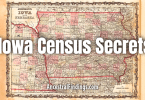The 1890 census may be gone, but your ancestors aren’t. This worksheet aims to help you rebuild the missing years—one clue at a time. Whether your ancestors were settling in a new state, welcoming children, remarrying, or passing on, they left traces in other records. This worksheet gives you a place to follow those trails, ask the right questions, and close the gap between 1880 and 1900.
Step 1: Where Were They in 1880?
Begin with what you know. Write down your ancestor’s full name, approximate age, and where they lived in 1880. Make note of other household members, occupations, and birthplaces.
Now ask: Did they own land? Did they live in a rural area or a city? Were neighbors or relatives listed nearby who might help track the family forward?
Step 2: Where Did They Show Up in 1900?
Next, locate your ancestor in the 1900 census. Record their age, location, occupation, household members, and marital status.
Now ask: What changed? Did they move states or counties? Are all the same children still in the home? Are there grandchildren, second spouses, or in-laws living with them? What clues can you gather about what happened in the intervening years?
Step 3: Search the 1890 Veterans Schedule
If your ancestor or their spouse was a Union veteran, check to see if they’re listed in the 1890 Veterans Schedule. Note their address, regiment, injuries, and years of service. Even if your direct ancestor isn’t there, look for neighbors with the same surname or widows who may be connected.
If you do find them, follow up with Civil War pension files—you may uncover detailed family history, affidavits, and even marriage or birth records filed as proof.
Step 4: Check State Censuses
Determine whether your ancestor lived in a state that conducted its census during the 1880s or 1890s. These include Iowa (1885, 1895), Minnesota (1895), New York (1892), New Jersey (1895), South Dakota (1895), and Florida (1885), among others.
If so, search the state census for your ancestor and note their address, household members, and any changes from earlier records. These state records are often digitized online or available through state archives.
Step 5: Explore City Directories
If your ancestor lived in a city or larger town, find the local city directories for the 1880s and 1890s. Write down their name, address, and occupation each year they appear.
Watch for years when they disappear or move locations—that can signal a death, remarriage, or move to another state. Track businesses they worked for or neighbors who may have been relatives.
Step 6: Search Local Land and Tax Records
Check with the county courthouse or archives for land deeds, tax rolls, or voter registrations between 1880 and 1900. Write down any land sales or purchases. Who was involved? Who signed the documents?
Land records may mention heirs, co-signers, or former owners with the same surname. Tax rolls can tell you when a family arrived or left a township, even if no census exists.
Step 7: Dig Into Newspapers
Search for your ancestor’s name in local newspapers between 1880 and 1900. Look for obituaries, marriages, court cases, business ads, property transfers, and travel announcements.
Jot down dates, locations, and any names mentioned alongside your ancestor. Sometimes, a single line in a small-town paper can explain a mystery you’ve been chasing for years.
Step 8: Use Church and School Records
Did your ancestor’s children attend school during the gap years? Did the family belong to a church or religious group? Contact local congregations or county historical societies for baptism, marriage, or burial records.
School registers and church rolls often list entire families and can place them in a specific location during the missing census years.
Step 9: Look Into Probate, Pensions, and Court Records
If someone in the family passed away in the 1880s or 1890s, search for probate records. Wills, guardianship files, and estate settlements can list heirs and family relationships.
If your ancestor was a Civil War veteran or widow, pension files from this period often contain rich personal information. These files might include family affidavits, letters, and supporting documents that list children, addresses, and life changes.
Final Notes: Building Your Timeline
As you work through this worksheet, build a timeline from 1880 to 1900. Start with where your ancestor was in 1880. Add any records you find—land, newspaper mentions, state census entries, and city directory listings. Finish with where they were in 1900.
This timeline will help you see where they moved, who entered their lives, and how their story unfolded despite the absence of the census.
The 1890 census may be gone, but the people it documented are still in the records they left behind. With persistence, creativity, and a willingness to follow new paths, you can still hear their stories. Keep asking questions, listening between the lines, and writing those stories down.






